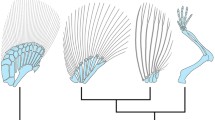Abstract
The Eph family is the largest known group of structurally related receptor tyrosine kinases (RTKs). Each Eph receptor has a specific Ephrin ligand, and these function to define spatial boundaries during development. Analyses of EphA4 in mouse, chick, frog and zebrafish embryos have implicated this gene in a number of developmental processes, including maintenance of segmental boundaries, axon guidance, limb development, neural crest migration and patterning of the ear. In order to determine which components of EphA4 function may be primitive for gnathostomes, we cloned EphA4 from the lesser spotted catshark (Scyliorhinus canicula) and examined its expression pattern during shark embryonic development. Consistent with the patterns reported for bony fish and tetrapods, we observed segmental expression of EphA4 in the developing hindbrain and later in the pharyngeal arches of shark embryos. EphA4 was also detected during sensory organogenesis, in the developing ear, eye, nasal pits and lateral line. A dynamic pattern of EphA4 expression occurs during shark fin development, suggesting an early role in outgrowth and patterning of the fin buds and a later role in tissue differentiation. We also observed several novel domains of EphA4 expression that have not been reported in other vertebrates, including external gill buds, dermal denticles, median fins and claspers. While some of these domains may reflect co-option of EphA4 expression to novel sites for development of shark-specific characters, others are more likely to be ancestral patterns of expression that were lost in other vertebrate lineages.




Similar content being viewed by others
References
Ballard WW, Mellinger J, Lechenault H (1993) A series of normal stages for development of Scyliorhinus canicula, the lesser spotted dogfish (Chondrichthyes; Scyliorhinidae). J Exp Zool 267:318–336
Bovenkamp DE, Greer P (1997) Novel Eph-family receptor tyrosine kinase is widely expressed in the developing zebrafish nervous system. Dev Dyn 209:166–181
Collazo A, Fraser SE, Mabee PM (1994) A dual embryonic origin for vertebrate mechanoreceptors. Science 264:426–430
Coombs S, Görner P, Münz H (1989) The mechanosensory lateral line: neurobiology and evolution. Springer, Berlin Heidelberg New York
Ellis J, Liu Q, Breitman M, Jenkins NA, Gilbert DJ, Copeland NG, Tempest HV, Warren S, Muir E, Schilling H et al (1995) Embryo brain kinase: a novel gene of the eph/elk receptor tyrosine kinase family. Mech Dev 52:319–341
Ford B (1921) A contribution to our knowledge of the life histories of the dogfishes landed at Plymouth. J Mar Biol Assoc 12:468–505
Helmbacher F, Schneider-Maunoury S, Topilko P, Tiret L, Charnay P (2000) Targeting of the EphA4 tyrosine kinase receptor affects dorsal/ventral pathfinding of limb motor axons. Development 127:3313–3324
Hirano S, Tanaka H, Ohta K, Norita M, Hoshino K, Meguro R, Kase M (1998) Normal ontogenic observations on the expression of Eph receptor tyrosine kinase, Cek8, in chick embryos. Anat Embryol 197:187–197
Kimmel CB, Miller CT, Moens CB (2001) Specification and morphogenesis of the zebrafish larval head skeleton. Dev Biol 233:239–257
Küry P, Gale N, Connor R, Pasquale E, Guthrie S (2000) Eph receptors and ephrin expression in cranial motor neurons and the branchial arches of the chick embryo. Mol Cell Neurosci 15:123–140
Mowbray C, Hammerschmidt M, Whitfield TT (2001) Expression of BMP signaling pathway members in the developing zebrafish inner ear and lateral line. Mech Dev 108:179–184
Nieto MA, Patel K, Wilkinson DG (1996) In situ hybridization analysis of chick embryos in whole mount and tissue sections. Methods Cell Biol 51:219–235
Patel K, Nittenberg R, D’Souza D, Irving C, Burt D, Wilkinson DG, Tickle C (1996) Expression and regulation of Cek-8, a cell to cell signaling receptor in developing chick limb buds. Development 122:1147–1155
Pickles JO, Claxton C, Van Heumen WR (2002) Complementary and layered expression of Ephs and ephrins in developing mouse inner ear. J Comp Neurol 449:207–216
Robinson V, Smith A, Flenniken AM, Wilkinson DG (1997) Roles of Eph receptors and ephrins in neural crest pathfinding. Cell Tissue Res 290:265–274
Swartz ME, Eberhart J, Pasquale EB, Krull CE (2001) EphA4/ephrin-A5 interactions in muscle precursor cell migration in the avian forelimb. Development 128:4669–4680
Xu Q, Mellitzer G, Robinson V, Wilkinson DG (1999) In vivo cell sorting in complementary segmental domains mediated by Eph receptors and ephrins. Nature 399:267–271
Acknowledgements
We thank Anthony Graham for providing the HNK1 antibody, and the Electron Microscopy Core Laboratory, Biotechnology Program, University of Florida for use of their facilities. R.F. is a Ph.D. student of the GABBA Graduate Program of Oporto University (Portugal) and was supported by a fellowship from FCT, Praxis XXI.
Author information
Authors and Affiliations
Corresponding author
Additional information
Edited by R. P. Elinson
Rights and permissions
About this article
Cite this article
Freitas, R., Cohn, M.J. Analysis of EphA4 in the lesser spotted catshark identifies a primitive gnathostome expression pattern and reveals co-option during evolution of shark-specific morphology. Dev Genes Evol 214, 466–472 (2004). https://doi.org/10.1007/s00427-004-0426-0
Received:
Accepted:
Published:
Issue Date:
DOI: https://doi.org/10.1007/s00427-004-0426-0




